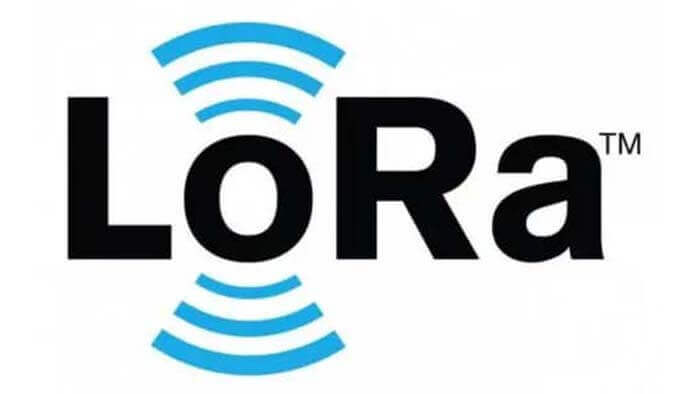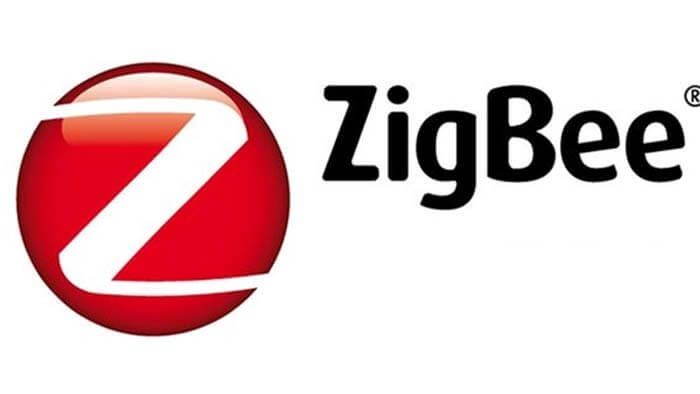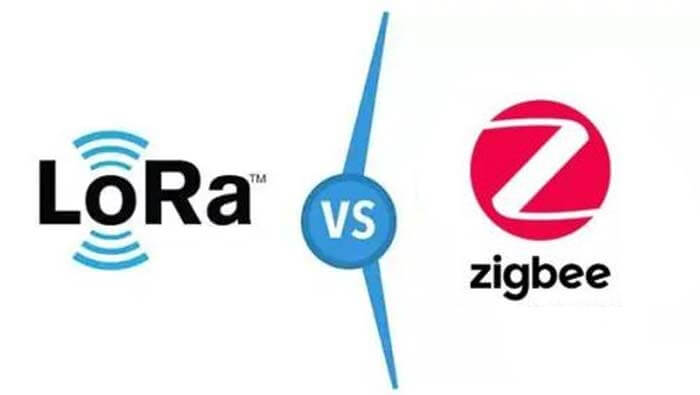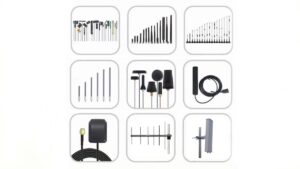After the analysis of LoRa vs. ZigBee technologies, you will learn about what is the difference between LoRa and ZigBee technology.
In LoRa vs. ZigBee technology, LoRa is a variety of wireless technologies for IoT applications, which can form a local area network or a wide area network.
In LoRa vs. ZigBee technology, ZigBee is a low-power local area network protocol based on the IEEE802.15.4 standard.
In LoRa vs. ZigBee technology, LoRa technology has the characteristics of long-range, low power consumption (long battery life), multi-node, and low cost.
In LoRa vs. ZigBee technology, ZigBee technology has the characteristics of close range, low complexity, low power consumption, low rate, and low cost.
LoRa vs. ZigBee's LoRa technology

There are various wireless technologies in IoT applications, which can form LAN or WAN. The wireless technologies for LAN mainly include Wi-Fi at 2.4 GHz, Bluetooth, Zigbee, etc. The wireless technologies for WAN mainly include 2G/3G/4G, etc.
Before Low Power Wide Area Network (LPWAN) was created, it seemed that there was only one choice between long-range and low power consumption. When LPWAN technology is adopted, designers can achieve both, maximizing longer-range communication and lowering power consumption, while saving additional repeater costs.
LoRa is one of the LPWAN communication technologies, which is a spread spectrum-based wireless transmission solution adopted and promoted by Semtech, Inc.
This solution changes the previous trade-off between transmission distance and power consumption and provides users with a simple system that enables long-distance, long battery life, and high capacity, thus extending the sensing network. Currently, LoRa operates mainly in global free bands, including 169 MHz 315MHz, 433MHz, 868MHz, 915MHz, etc.
Lora changes the old way of thinking about the trade-off between transmission distance and power consumption. It provides users with a simple wireless communication solution that enables long range, long battery life, and high capacity.
In LoRa vs ZigBee technology, LoRa technology has the characteristics of long-distance, low power consumption (long battery life), multi-node, and low cost.
LoRa vs. ZigBee's LoRa features
Supports low power consumption
The LoRa communication protocol has a receive current of only 10mA and a sleep current of <200nA, which greatly extends the battery life and reduces the power consumption of battery-powered devices.
Long transmission distance
Traditional ASK, FSK, Bluetooth and other wireless transmission distance is less than 100 meters, by increasing the power can reach 1000 meters or more. Lora can reach up to 10 km at low speed and in the open.
Under the same conditions, Lora’s wireless transmission distance is much longer.
Principle: The signal-to-noise ratio of the LoRa demodulated signal is -20dB, which is 30dB higher than FM FSK, which equates to a many-fold increase in range and distance. Outdoor, a 6dB difference can achieve 2 times the original transmission distance.
Anti-interference
LoRa wireless communication uses spread spectrum technology and greatly improves the anti-interference capability of wireless communication through a high spread spectrum factor. Even if the same frequency is used to send signals to the host at the same time, they will not interfere with each other, completely solving the pain point that wireless signal communication is easy to be interfered with.
Stronger penetration
LoRa’s wireless penetration is stronger, I Lora wireless module 20dbM transmitting power, 470Mhz wireless transmission frequency, after our actual test than the traditional ASK use of wall penetration ability increased by more than 5 times.
Data rate of wireless communication
Lora supports half-duplex wireless communication at 292bps-5.4kbps. It can support the wireless upgrades of device firmware. It can meet the demand for IoT applications.
LoRa uses digital spread spectrum, digital signal processing, and predecessor error correction coding technology to provide unprecedented performance, making it the best solution for IoT LAN communications.
LoRa vs. ZigBee's LoRa disadvantage
Lora wireless communication technology and patents, as well as the production of chips, are monopolized by the U.S. Semtech, as well as the LoraWan technology about Lora, is also developed by the U.S. semtech.
LoRa vs. ZigBee's LoRa features
The development of LoraWan has stagnated in these years due to changes in policy and market. But it does not affect the application of Lora wireless communication technology point-to-point wireless data transmission, smart home, industrial data transmission, etc. The application of the industry is very wide.
LoRa vs. ZigBee's ZigBee technology

ZigBee is a low-power local area network protocol based on the IEEE 802.15.4 standard. A local area network wireless communication technology is being used by most smart home intelligence products on the market today.
ZigBee technology is a close-range, low-complexity, low-power, low-rate, low-cost two-way wireless communication technology.
It is mainly used for data transmission between various electronic devices with short distances, low power consumption, and low transmission rate as well as typical applications with periodic data, intermittent data, and low response time data transmission.
ZigBee is a wireless connection that works in three frequency bands, 2.4 GHz (popular worldwide), 868 MHz (popular in Europe), and 915 MHz (popular in the United States), with transmission rates of up to 250 kbit/s, 20 kbit/s, and 40 kbit/s, respectively, and its transmission distance is in the range of 10-75 m but can continue to increase.
As a wireless communication technology, ZigBee has the following features.
LoRa vs. ZigBee's ZigBee features
Low power consumption
Because of the low transmission rate of ZigBee, the transmit power is only 1mW, and the sleep mode is used, the power consumption is low, so ZigBee devices are very power-saving. According to estimates, ZigBee devices rely only on two No. 5 batteries that can be maintained for up to 6 months to about 2 years of use, which is unmatched by other wireless devices.
Short-time delay
Therefore, ZigBee technology is suitable for demanding wireless control (such as industrial control applications, etc.) applications.
Large network capacity
A star structure Zigbee network can accommodate up to 254 slave devices and one master device, and up to 100 ZigBee networks can exist simultaneously in a region, and the network composition is flexible.
Reliability
The MAC layer adopts a fully acknowledged data transmission mode, where each transmitted packet must wait for an acknowledgment message from the receiver. If a problem occurs during transmission, it can be retransmitted.
Security
ZigBee provides packet integrity checks based on cyclic redundancy checks (CRC), supports authentication and authentication, and adopts the AES-128 encryption algorithm so that each application can flexibly determine its security attributes.
LoRa vs. ZigBee's ZigBee disvdvantages
High cost
Zigbee protocols are complex, with high technical thresholds, and require a lot of manpower for research and development in the early stages, which greatly hinders the progress of the project and the launch of the product. The cost of the module is between 15-30, which is high for a low-cost detector.
Poor penetration and short transmission distance
Short transmission distance and poor penetration (wall penetration) are the biggest pain points of Zigbee. However, with the implantation of mesh and cascade algorithms, Zigbee can basically meet the smart home system of small families.
LoRa vs. ZigBee's ZigBee applications
Zigbee technology is particularly suitable for small amounts of data swallowing leaves, low investment in network construction, high network security requirements, and inconvenient frequent battery replacement or charging, and is expected to be widely used in consumer electronics, home intelligence, industrial control, medical equipment control, agricultural automation, and other fields.
To sum up, Lora vs. Zigbee technology, we find that in fact Zigbee and Lora both belong to low-power LAN wireless communication technology, strong anti-interference ability, and other common points, but the advantages of Lora in wireless transmission distance and wireless penetration are beyond the reach of Zigbee technology.
Besides the What is Lora vs. Zigbee article, you may also be interested in the below articles.
PCB Antenna VS. External Antenna
Ceramic Antenna VS. PCB Antenna, A Comparison Guide
Wifi vs. 5G, is 5G better than Wifi?
Mobile Networks’ Evolution From 1G To 5G




